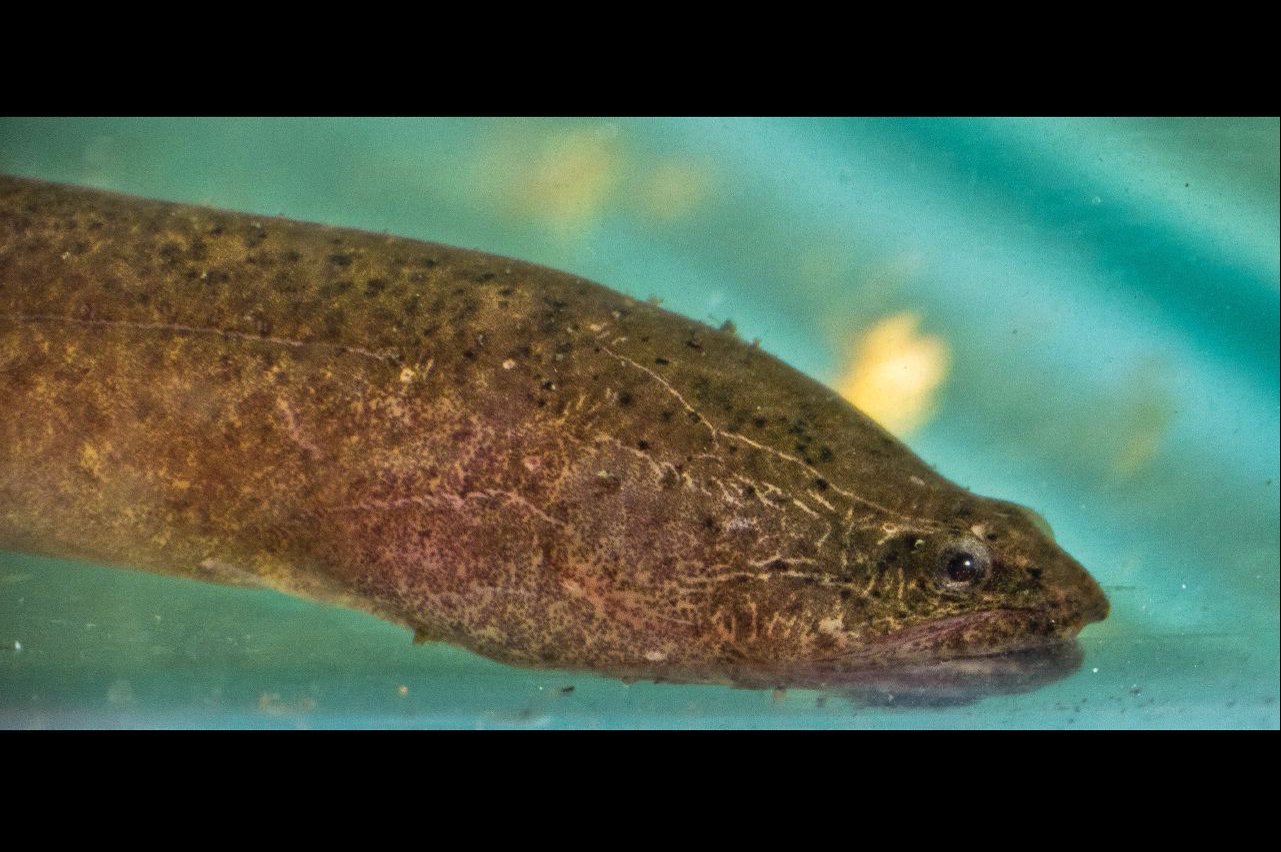Swamp Eel, Ophisternon gutturale (Richardson 1845)

Head of a Swamp Eel, Ophisternon gutturale, from Fish River Station, Douglas Daly Research Farm, Northern Territory, April 2012. Source: Robert Whyte / Flickr. License: CC by Attribution-NonCommercial-NoDerivatives
A greenish to brown swamp-eel with a darker back and often dark spotting or mottling. This nocturnally active eel-like fish can survive short periods out of water.
Swamp Eel, Ophisternon gutturale (Richardson 1845)
More Info
|
Distribution |
Found in northern Australia in the Gulf of Carpentaria, Victoria River and Timor Sea drainage divisions. Known from the Dampier Archipelago, Western Australia, through the north coast of the Northern Territory to about Townsville, Queensland. Elsewhere in southern Papua New Guinea. The Swamp Eel burrows into soft bottom sediments in quiet, well-vegetated backwaters of brackish estuaries, the lower freshwater reaches of rivers, and nearby swamps. |
|
Features |
Body eel-like, elongate and slender; head short, broad; snout short, less than half the length of the upper jaw, distance from middle of eye to snout tip 59-67% of distance from snout tip to rear corner of mouth; upper lip thick; gill opening a small slit located ventrally at the back of the head; teeth present on the premaxilla, dentary, palatine, and ectopterygoid; eyes small, well forward in skull, forward of vertical from the midpoint of upper lip, and covered by dense skin; anterior and posterior nostrils present; 38 to 53 caudal vertebrae; anus in posterior part of body. Scales absent; lateral-line conspicuous. Dorsal and anal fins reduced to folds of skin on posterior part of body; pectoral and pelvic fins absent. |
|
Size |
To 60 cm TL, commonly to 20cm. |
|
Colour |
Variable, usually brown to greenish overall and darker dorsally, sometimes with dark spotting or mottling. |
|
Feeding |
Likely to feed on insects, fishes and aquatic invertebrates. |
|
Biology |
Little is known of the biology of this species - likely to be a protogynous hermaphrodite, laying large eggs in a burrow in soft sediments. |
|
Conservation |
Not listed |
|
Similar Species |
Ophisternon gutturale is most similar to O. bengalese but differs in the distance from middle eye to snout tip which is 59-76% of the distance from snout tip to rear corner of mouth versus 37-50% in O. bengalese. |
|
Species Citation |
Synbranchus gutturalis Richardson 1845, Zool. Voy. Erebus Terror 2: 49 pl. 30. Type locality: Dampier Archipelago, Western Australia. |
|
Author |
Vanessa J. Thompson & Dianne J. Bray |
|
Resources |
Swamp Eel, Ophisternon gutturale (Richardson 1845)
References
Allen, G.R. (1982). Inland Fishes of Western Australia. Perth : Western Australian Museum 86 pp.
Allen, G.R. (1989). Freshwater Fishes of Australia. Neptune, New Jersey : T.F.H. Publications pp. 1–240
Allen, G.R., Midgley, S.H. & Allen, M. (2002). Field guide to the freshwater fishes of Australia. Perth : Western Australian Museum 394 pp.
Larson, H.K. & Martin, K.C. 1990. Freshwater Fishes of the Northern Territory. Northern Territory Museum of Arts and Sciences Handbook Series Number 1. Darwin : Northern Territory Museum of Arts and Sciences 102 pp. 73 figs.
Merrick, J.R. & Schmida, G.E. (1984). Australian Freshwater Fishes Biology and Management. Sydney : J.R. Merrick 409 pp.
Pusey B., Kennard M. & Arthington A. (2004) Freshwater Fishes of North-Eastern Australia. CSIRO Publishing, Collingwood, Victoria.
Richardson, J. (1845). Ichthyology. pp. 17–52 pls 7–8 (parts), 11–30 in Richardson, J. & Gray, J.E. (eds) The Zoology of the Voyage of H.M.S. Erebus and Terror under the Command of Captain Sir James Clark Ross, R.N., F.R.S., during the years 1839–43. London : E.W. Janson Vol. 2 139 pp.




